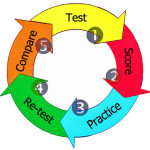Medical Device Sales Workshop + Practice Technology
Make a typical sales representative 20 times more likely to say the right thing at the right time!
Do V.P.’s of sales, sales trainers or managers ever speak in sports metaphors when addressing or training your medical sales force? They talk about medical sales as being analogous to football, baseball, track and field, etc. They talk about sales as a “game” and how to create a winning game strategy. They talk about the need to know how to block and tackle. They talk about the importance of knowing how to hit a curve ball. And they talk about succeeding long term by referring to the sprint vs. the marathon. But there is one thing that is consistently missing in sales when using sports as a metaphor for winning teams, and it is the one thing that sports teams do regularly, relentlessly, and consistently…
…PRACTICE
Think about it…would a coach with any expectation of winning ever limit his team to one training/practice session without practicing the rest of the season? It would be ludicrous, right? Then why does almost every company expect their sales people to perform like winning athletes without practicing? Because practicing outside of the training environment has never been practical. In order for effective practice to be possible, it needs to be:
Bridging the Gap Between Knowing and Selling
The Results-oriented Comprehensive Engagement Process combines interactive live training with with ongoing, intense sales practice. Sales Pilot Medical Sales Performance uses a new computer-based practice technology that allows your sales associates to practice key sales message components wherever and whenever they want. Most importantly though, it ensures that they :
- master the key talking points of the products they present
- handle objections appropriately, confidently, and effectively
- deliver a brand message that is on-target, complete, and consistent
- are selling in compliance with all regulatory requirements
- stay focused on the customer because they won’t need to be thinking about what to say next
That which is monitored gets done. That which is monitored AND measured gets done well.
You know who is using the practice tool and who isn’t. Every Monday morning, up to four levels of managers are emailed a report that shows when each salesperson practiced and for how long (it only logs actual practice time—not the amount of time logged-in, so they can’t fake it), and how they scored in the practice session. More importantly, you’ll know that they used it by their sales increases!
When salespeople internalize the key sales messages and responses, they become unconsciously competent, that is, they respond appropriately and automatically during sales situations.
In his landmark book, The Talent Code, author Daniel Coyle reveals, “There is, biologically speaking, no substitute for attentive repetition. Nothing you can do–talking, thinking, reading, imagining–is more effective in building skill than executing the action, firing the impulse down the nerve fiber, fixing errors, honing the circuit.” 1
Sales Pilot bridges the gap between knowing and doing with The Sales Simulator™.
The Sales Simulator™ consists of two components:
1. Live interactive sales practice guided by a training syllabus patterned after airline pilot flight training where the sales person learns the components of selling sequentially under the watchful eye of the sales trainer
2. Ongoing practice using a computer-based practice tool that allows the sales associate to perfect and internalize the key talking points.
Does computer-based study and practice produce measureable results?
Adam Rapp, MBA, Ph.D., Assistant Professor at Clemson University completed a study of involving 1,000 Fortune Five Hundred sales representatives using the practice technology. He discovered that a typical sales representative was only able to deliver approximately 10% of their intended message after a sales training program; up to 20% if role-play was included.
So if a sales representative was only delivering 10-20% of the intended message, then what was the other 80-90%? It was information that the sales rep believed was important, something they had heard before, or something they made up!
The same sales representatives used the practice technology to study and practice for one hour. When asked to deliver the message after that time period, the typical sales representative was able to deliver approximately 90% of the intended message. According to the study, “the software tool demonstrated a statistically significant impact on key discussion points remembered and parts of the brand/product message delivered.”
In-Field Benchmark Results
 At the beginning of every client engagement, a benchmark assessment is completed. The results of all benchmark assessments completed to date mirror the results of the Clemson University study. The typical sales representative delivers between ten to twenty percent of their intended message before practicing. After practicing, sales representatives deliver over 90% of their intended message. Further, follow-up assessments reveal that sales representatives retain the ability to perform over a long period of time.
At the beginning of every client engagement, a benchmark assessment is completed. The results of all benchmark assessments completed to date mirror the results of the Clemson University study. The typical sales representative delivers between ten to twenty percent of their intended message before practicing. After practicing, sales representatives deliver over 90% of their intended message. Further, follow-up assessments reveal that sales representatives retain the ability to perform over a long period of time.
To review two case studies with companies that sell to healthcare CLICK HERE.
How much could you increase sales if you could bring the average sales performers in your sales force up to the level of your top sales performers? If you would like to find out how this can be done, please call Sales Pilot at 561.333.8080.
1. Daniel Coyle, The Talent Code : Greatness isn’t Born. It’s Grown. Here’s How, (Bantam Dell, Division of Random House, May 2009) p 87